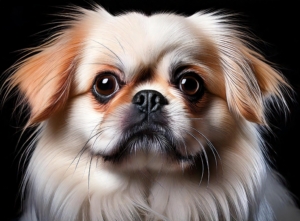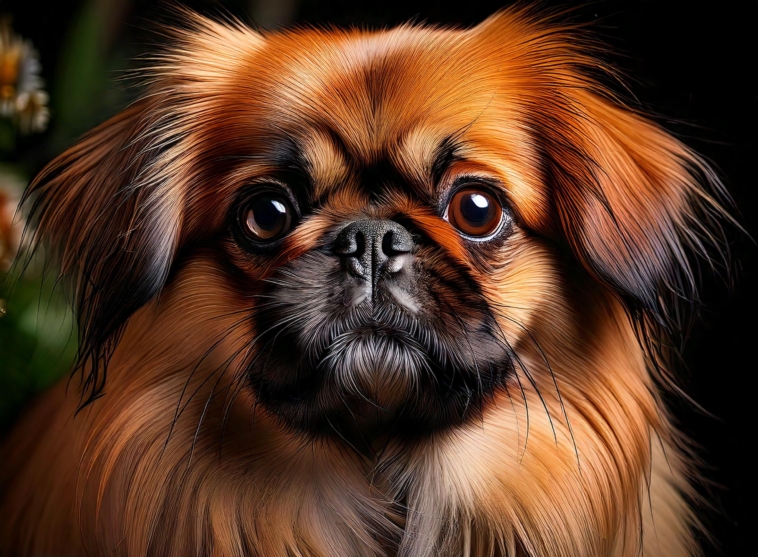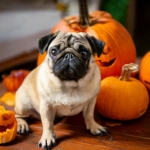So You Want a Pekingese? Welcome to Royalty on Four Legs
Ah, the Pekingese — a dog that believes it’s royalty (and really, it is). This teeny-tiny lion of the dog kingdom comes from China, where it used to recline in imperial palaces and likely criticized everyone.
Looks That Say “I Own This Palace”
- Size: Small in height, large in personality — they typically weigh 6 to 16 pounds, although their ego tips the scales at several hundred pounds more.
- Coat: Soft, long, and double-coated. Essentially, they’re a walking fur coat with an attitude.
- Face: Flat and unapologetic about it — this brachycephalic nose makes them look like one very self-satisfied pancake.
- Ears: Feathered and heart-shaped. Because why not resemble a Valentine’s Day mascot?
The Temperament of a Tiny Emperor
- Personality: Independent? Yes. Stubborn? Definitely. Cooperative? Only when it suits them.
- Behavior: Guarded, loyal, and otherwise polite — unless you are a stranger, in which case they will give you the cold shoulder.
- Social Skills: Early instruction is key. Without it, they will instruct you.
Pekingese Health: Delicate But Demanding
- Common Problems: Breathing issues, joint theatrics, and drama queen vet visit.
- Care Routine: Hair salon-worthy grooming, haute cuisine, and personal doctor (aka your veterinarian).
Why Having a Pekingese Is Like Winning the Dog Lottery
They’re refined, loyal, and wonderfully melodramatic. Essentially, they’re the canine equivalent of a velvet robe and crown.
Understanding the Pekingese Personality (Or Trying To)
Pekingese are sweet, tender, and mysterious — sort of like an emotionally aloof poet in a fur coat.
- Loyalty: If you’ve got it, they’ll protect you like a little lion on a velvet cushion.
- Courage: Little body, large “don’t mess with me” attitude.
- Stubbornness: They have tantrums that would put a toddler to shame.
- Alertness: Hyper-alert and liable to overreact dramatically to literally anything.
Frankly, they seem to moonlight as royal consultants.
Preparing Your Home for the Furry Overlord
Before your new royal arrives, here’s what to do:
- Safe Spaces: They require individual hideaways to recover from all that sleeping.
- Joint-Friendly Beds: Because even emperors require orthopedic assistance.
- Climate Control: These flat faces heat up quicker than your phone on a warm dashboard.
- Grooming Arsenal: Brushes, combs, nail clippers — essentially a home salon.
- Toys: They love puzzles more than your typical crossword nutcase.
Feeding a Pekingese: Culinary Excellence Only
These tiny gourmets require meals worthy of a royal court:
- Protein: For royal muscle building — chicken, lamb, or fish.
- Fat: To keep them looking sharp with shiny coats and endless attitude.
- Carbs: Brown rice and sweet potatoes for royal stamina that lasts.
- Vitamins: Carrots and spinach to prevent palace plagues (or mere general health problems).
- Portion Control: Because this breed transitions from “cute and puffy” to “rolling potato” in no time.
- Hydration: Water is not optional. Fill the royal goblet (or bowl).
Grooming Your Pekingese: Spa Day, Every Day
That beautiful mane requires TLC — Tangled Locks Committee (Pekingese version):
- Brushing: Weekly brushing (at least!) or they’ll mat quicker than a spaghetti dinner.
- Bathing: Every 3–4 weeks with real dog shampoo. Not your herbal lavender mixture.
- Trimming: Especially around the eyes, ears, and paws, unless mystery animals are okay with you.
- Ears: Clean them often, unless ear infections are your agenda.
- Teeth: Brush every day unless you’re wanting to finance your vet’s new automobile.
- Nails: Trim monthly or face click-clack bedlam across the house.

Exercise: Yes, Even Royalty Must Move
They’re not really athletic, but they do need to wriggle occasionally.
- Daily Walks: 15 minutes of majestic strolling.
- Indoor Play: A game of fetch or tug fit for a royal. Enthusiasm at your discretion.
- Social Time: Assists with dealing with peasants (strangers and other animals).
- Puzzle Toys: Their heads also need a workout.
- Avoid Overexertion: Don’t push them — they’ll signal you with an extremely theatric sigh.
Training & Socialization: AKA Negotiations with a Furry Dictator
It takes more diplomacy to train a Pekingese than to negotiate with a foreign government. They don’t obey. They take requests into consideration.
- Begin Early: Or be perpetually enslaved by a furry dictator.
- Positive Reinforcement: Treats are more effective than threats. Always.
- Short Sessions: Short and sweet like royal decrees.
- Develop Confidence: Socialize early so that they won’t become suspecious about the mail carrier.
- Consistency: They’ll push your patience to the limit, so keep the routine tight.
Health Concerns: What the Royal Doctor Should Know
As with any king, Pekingese have their maladies:
- Brachycephalic Syndrome: Royal nose = respiratory drama.
- Back Problems (IVDD): Royal backs need royal cushioning.
- Eye Issues: Their royal peepers are sensitive and subject to damage.
Prevention Plan:
-
Regular vet visits
-
Watch their weight like it’s national security
-
Gentle grooming
-
Sensible exercise
Routine Vet Care: The Royal Health Portfolio
Regular checkups catch issues before your royal highness begins dramatically coughing in indignation.
- Vaccinations: In order to maintain the court plague-free.
- Dental Cleanings: Their teeth aren’t for show.
- Weight Checks: Fatty royals are not healthy royals.
- Coat Checks: Dirt and detritus? Not on this smooth sovereign
Traveling With a Pekingese: Pack the Throne
Pekingese are sensitive travelers. You’re not going on vacation — you’re transporting royalty.
- Pre-Trip: Vet visit, check-up, vaccination paperwork — the royal visa.
- Crate: Spacious and comfy, like a mobile throne room.
- ID Tags: Just in case your highness wanders off.
- On the Road: Frequent stops, air control, hydration, and complaints — lots of those.
- At Destination: Only book pet-friendly places, and locate the nearest emergency vet in case royal allergies arise.
Love and Loyalty: The Pekingese Bond
Pekingese can be diva-like, but they’ll win your heart (and your best spot on the couch).
- Quality Time: Pet, play, spoil — they demand no less.
- Respect Boundaries: When they need their space, give it to them — or else the royal glare.
- Mental Engagement: Puzzles and toys to challenge that royal brain.
- Consistent Care: A routine befitting a king — or a fluffy, snooty duchess.
Golden Years: Senior Pekingese Care
Your mature fluffball will require a little extra TLC:
- Senior Diet: Low-calorie, high-fiber — spa food for kings and queens.
- Regular Vet Visits: Because aging monarchs require more visits from the vet.
- Exercise: Short, gentle, and regal.
- Comfort: Plush bedding, no staircases of despair.
- Meds: Take your vet’s advice — no royal defiance permitted.
Pekingese Owner Essentials: The Royal Toolkit
If you’re serious about taking care of your little monarch in style, stock up:
- Grooming Kit: Shampoo, scissors, brushes — all but a tiara (optional).
- Diet Guide: Food for miniature, mouthy royalty.
- Training Materials: Books, videos, perhaps even a dog whisperer.
- Pekingese Clubs: Join the fan club — fellow servants, I mean owners, will commiserate with you.
Final Words
Having a Pekingese as a companion is like having a fuzzy, flat-faced drama queen on your couch — who loves you intensely and looks amazing while doing so. Treat them as royalty, and they will reward you with loyalty, side-eye, and lots of snuggles (on their own terms, naturally).



